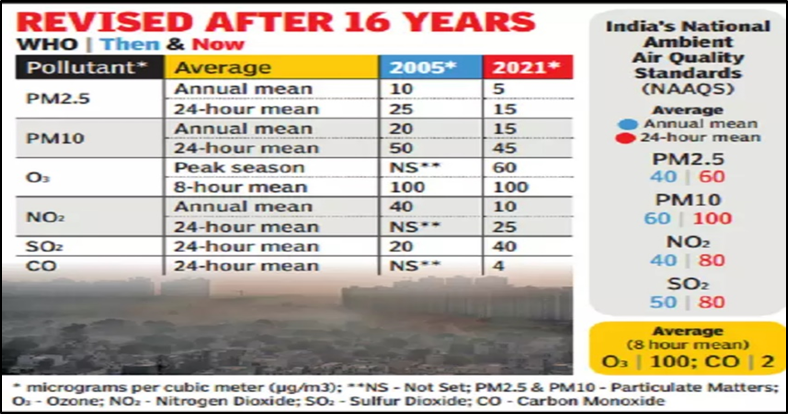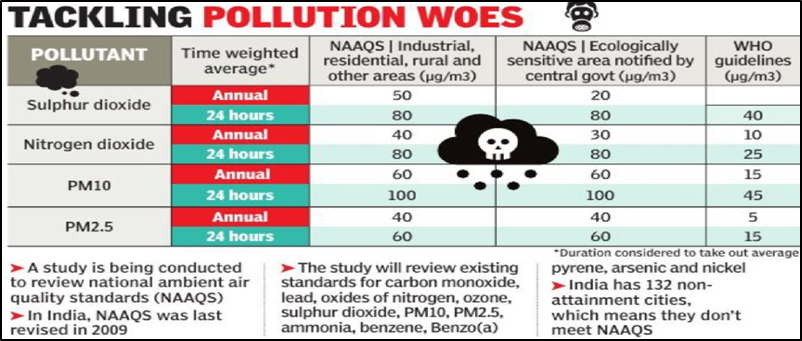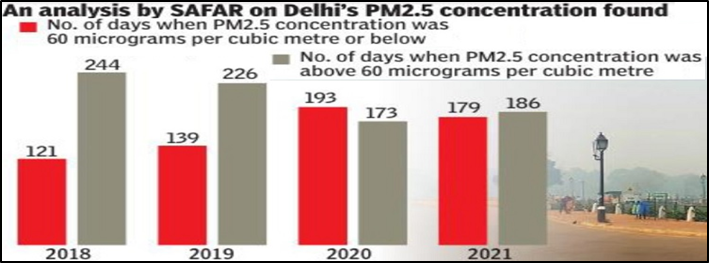In News:
- A one-year study by IIT-Kanpur has been sanctioned to review the national ambient air quality standards (NAAQS).
- This has been revealed by a RTI reply from Central Pollution Control Board (CPCB).
What’s in Today’s Article:
- National Ambient Air Quality Standards (NAAQS)
- WHO’s revised air quality guidelines 2021
- News Summary
In Focus: National Ambient Air Quality Standards (NAAQS)
About
- Ambient air quality refers to the condition or quality of air surrounding us in the outdoors.
- Under the authority of the Air (Prevention and Control of Pollution) Act of 1981, India’s Central Pollution Control Board sets national ambient air quality standards.
- The current National Ambient Air Quality Standards include following pollutants
- Sulphur Dioxide (SO2), Nitrogen Dioxide (NO2), Particulate Matter (size less than 10 µm), Particulate Matter (size less than 2.5 µm), Ozone (O3),
- Lead (Pb), Carbon Monoxide (CO), Ammonia (NH3), Benzene (C6H6), Benzo(a)Pyrene (BaP)- particulate phase only, Arsenic (As), Nickel (Ni).
WHO’s revised air quality guidelines 2021

- In September 2021, the World Health Organization (WHO) has strengthened its air quality guidelines.
- The revised norms recommend air quality levels for six pollutants:
- Ozone, nitrogen dioxide, sulphur dioxide and carbon monoxide.
- The other two are PM10 and PM2.5 -- particulate matter equal or smaller than 10 and 2.5 microns in diameter.
- The recommended levels for all the six pollutants have been revised downwards from the existing norms that have been in place since 2005.
- The WHO norms are not binding on any country.
- These are only recommended norms considered safe for human health, backed by scientific studies. However, air quality does affect the international image of a country.
News Summary
- A recent RTI reply from CPCB has revealed that a one-year study by IIT-Kanpur has been sanctioned to review the national ambient air quality standards (NAAQS).
- Any changes to the current national standards will depend on the findings of the study.

Necessity to revise the national air quality guidelines
- Demand from various quarters
- India had last revised its National Ambient Air Quality Standards in 2009.
- On the other hand, World Health Organization (WHO) had revised its air quality guidelines in 2021.
- As a result, experts have been calling for revision of the standards.
- Lenient air quality standards of India
- India’s own national air quality standards are much more lenient, even compared to WHO’s 2005 norms.
- g., the recommended PM2.5 concentration over a 24-hour period is 60 micrograms per cubic metre, compared to 25 micrograms advised by WHO’s 2005 guidelines.
- Also, the annual national standard forPM10 and PM2. 5 is still 60 and40 micrograms per cubic metre, respectively.
- On the other hand, WHO’s safe limit of 15 micrograms per cubic metre forPM10 and 5 micrograms per-cubic metre for PM2. 5 (as per 2021 guidelines).
- Increasing pollution woes

Steps Taken by the Indian Govt
- National Clean Air Programme (NCAP)
- NCAP was launched in January 2019 to improve air quality through a city-specific action plan.
- Under NCAP, India has a target to reduce 20-30% of PM2.5 and PM10 concentrations by 2024 from 2017 levels.
- PRANA Portal
- It was launched to monitor the implementation of NCAP
- National Air Quality Index (AQI) –
- It was launched in October 2014 to disseminate information on air quality in an easily understandable form for the general public.
- The measurement of air quality is based on eight pollutants, namely, PM10, PM2.5, NO2, SO2, CO, O3, NH3, and Pb
- Under the authority of the Air (Prevention and Control of Pollution) Act of 1981, India’s Central Pollution Control Board sets national ambient air quality standards.












